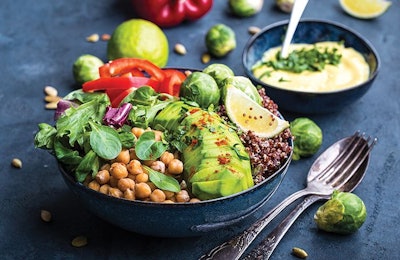
Clean eating is one of the top diet trends of 2019. It’s an opportunity for the poultry industry to engage with consumers and cement itself as part of a healthy diet.
Dieters say they want to eat clean
Those in the food industry, or those who’ve ever struggled with their weight, know there’s always a new diet trend around the corner. The big trend in 2019 may well be the dominance of what’s known as clean eating.
In May 2019, the International Food Information Council (IFIC) Foundation published the results of its annual Food and Health Survey. It polls about 1,000 American consumers on dietary and food-related trends. The IFIC is “dedicated to the mission of effectively communicating science-based information on health, nutrition and food safety for the public good.”
The top diet buzzword this year is clean eating. In the first year of asking specifically about clean eating, the survey found that 10% of people who said they are following a specific diet or eating pattern are attempting “clean eating.” That makes it the top diet trend, beating out intermittent fasting (9%), gluten-free (6%), low-carb (6%) and ketogenic (6%) diets. Overall, 38% of the survey group said they were on a diet.
Clean eating (un)defined
Clean eating is an amorphous term, which, on its face, carries no obvious nutritional or caloric restrictions. This is unlike other diets which require dieters to eschew certain tempting food groups. A quick Google search reveals no less than 590 million results for the term. In fact, there’s an entire magazine, Clean Eating, which focuses on this concept and lifestyle.
The lack of a hard-and-fast precept makes it hard to define what exactly a clean eating plan looks like, but the common thread appears to be: avoiding processed, packaged foods rich with sugar, salt and artificial ingredients; choosing so-called real foods or whole foods over refined foods; and avoiding drinking your calories through alcoholic or sugary beverages. Some plans call for eating more plant-based proteins instead of animal proteins, as well.
At its core, the program looks like a variation of the classic consume-less-calories-and-choose-more-nutritious-foods advice doctors and dieticians have dispensed for decades. Now, it’s repackaged as a wholesome lifestyle choice rather than a restrictive, eat-this-don’t-eat-that plan. Promoters of the plan promise everything from weight loss to a happier life for the program’s adherents.
Where poultry fits in
Chicken, turkey and eggs should be able find a good home in shopping baskets and refrigerators of clean eaters. Poultry products are often sold fresh, unseasoned and free of any artificial ingredients. To boot, the raw products – meat and eggs – are low in fat, high in protein and nutritionally dense. Like I’ve said before, sell the benefit.
On the positive, the growth of clean eating should be seen as a vote of confidence for integrators who are investing in lines of products promising more than the standard commodity chicken. Clean eaters may choose the higher-priced chicken sporting the no-antibiotics-ever and vegetarian-fed diet labels because it fits better with their program.
On the negative, this could be a headwind for producers of value-added poultry products. Those making deli meats, sausage and nugget products – that include added sodium or artificial ingredients used as flavorings and preservatives – may suffer as consumers increasingly reject these products for being overly processed. Moreover, if clean eating becomes more mainstream sales of par-fried and breaded chicken products made to be fried may suffer, too.
My key takeaway is that poultry producers should always be aware of consumer attitudes and diet trends and should keep their product line current to deliver relevant products. Of course, most people will always go for the cheap, tasty and safe-to-eat product. However, those following a clean eating plan seem to be more likely to spend more on a product they perceive as being healthier. This, I think, is a great opportunity for savvy chicken and turkey marketers to move their more expensive to produce and more profitable items.
Get more consumer insights at the 2019 Chicken Marketing Summit
Find out how channels, choices and challengers influence consumers’ chicken purchasing behavior at the 2019 edition of Chicken Marketing Summit scheduled for July 21-23 at the Belmond Charleston Place in Charleston, South Carolina. Registration is now open.

















